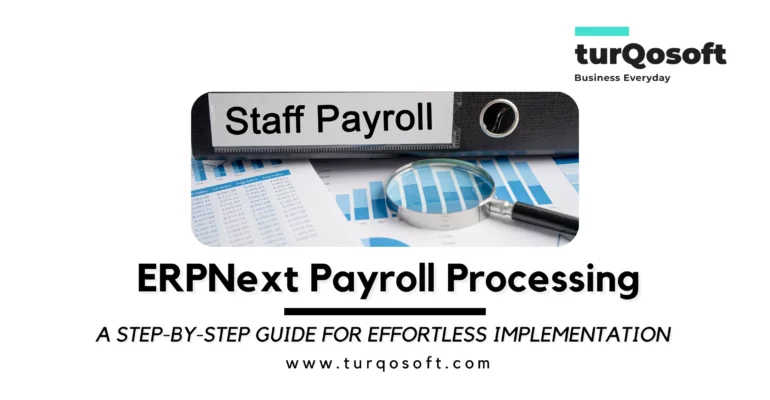ERPNext Payroll Processing: A Step-by-Step Guide for Effortless Implementation

ERPNext Payroll Processing: A Step-by-Step Guide for Effortless Implementation
Hey there! If you’ve ever found yourself scratching your head over ERPNext Payroll, you’re not alone. Payroll might seem like a tricky beast, especially when you’re just starting out. But fear not! This blog post is here to be your friendly guide through the world of ERPNext Payroll.

Picture this: you’re on a quest to make your business run smoother, and payroll is a big part of that journey. The tricky part usually comes in the beginning when you’re setting things up. But guess what? Once you’ve got that part sorted, the rest becomes a breeze. So, grab a cup of coffee, and let’s break down ERPNext Payroll together.
Master Payroll Processing in ERPNext: Ultimate Guide
Whether you’re a business owner wanting to make payroll a walk in the park or someone curious about ERPNext, this guide is made just for you. We’re going to take you through the steps in simple terms – no jargon, no confusion. We’ll cover how to set things up, handle taxes, create salary bits, and, most importantly, how to make sure your payroll entries are spot on.
So, if you’re ready to make payroll your new best friend instead of a headache, let’s dive into ERPNext Payroll together. We promise to keep it easy, fun, and most importantly, super helpful for you and your business!

Create Payroll Period
The first step involves defining the period for payroll processing. Whether it’s a calendar year from January to December or a fiscal year from April to March, aligning the payroll period with your company’s structure is crucial.
Create Income Tax Slabs
For organizations following the Indian Income Tax system, this step allows the creation of multiple income tax slabs in accordance with government regulations. Additional tax options can be added, and conditions can be specified. Ensuring tax exemption is enabled is essential for cases where standard deductions apply.
Submit Employee Tax Exemption Declaration
Employees with investments can submit tax declarations to avail of tax benefits, reducing their overall income tax liability. This step is particularly relevant for Indian taxation, allowing employees to invest in various categories under sections like 80C, 80D, etc.
Define Salary Components
Creating salary components is a pivotal step. These components can be categorized as earnings or deductions, with the option to set specific checkboxes depending on the type. Salary components may be formula-based or fixed amounts. Notably, for income tax components, enabling “Variable based on Taxable Salary” ensures automatic backend calculation of income tax.
Create a Salary Structure
Once all salary components are in place, defining a salary structure becomes essential. This structure can be based on timesheets, and you have the flexibility to add earnings and deductions as per your preferences and chosen payment mode.
Assign the Salary Structure
Assigning salary structures to employees is a crucial but sometimes overlooked step. During this process, selecting the appropriate income tax slab is vital, especially when multiple slabs exist. This selection influences the percentage deduction of income tax, and you may also define a base amount if your salary structures are formula-based.
Create a Payroll Entry & Salary Slips
With the groundwork laid, creating a payroll entry is the next logical step. After specifying the payroll date, frequency, and payment account, employees can be filtered based on department, designation, and branch. Generating salary slips is a straightforward process, and thorough verification before submission ensures accuracy. Upon submission, an accrual journal entry is created, recording salary expenses within the system.
Bank Entry
As the final step, a bank entry is required to complete the payroll process. This step signifies the closure of the payroll cycle in ERPNext, though it’s important to note that the actual transfer of salaries to bank accounts requires a separate manual process.
Conclusion
Congratulations! You’ve just embarked on a journey towards mastering ERPNext Payroll. We’ve demystified the process, turning what might have seemed complex into manageable, bite-sized steps. Now, armed with this knowledge, you can confidently navigate the intricacies of payroll management in ERPNext, ensuring your business operates with precision and efficiency.
But remember, mastery comes with practice. So, whether you’re a seasoned ERPNext user or just getting started, don’t hesitate to revisit this guide as needed. And as you put these insights into action, you’ll find that processing payroll becomes not just a task but an opportunity for your business to thrive.
Are you ready to supercharge your payroll process and unlock the full potential of ERPNext? Take the next step and implement these tips today. If you have questions along the way or want to share your success stories, we’re here for you. Drop a comment below, connect with us on social media, or reach out through our support channels.
Here’s to effortless payroll processing, increased efficiency, and the success of your business. Happy navigating with ERPNext.
If you’re looking for expert assistance to implement, customize and support ERPNext and unlock its full potential for your business, we’re here to help. Drop us a message, and our experienced team will be delighted to guide you.
You can reach us via email at info@15.206.92.4 or give us a call at +91 9841205845.
Or, stay connected with us on LinkedIn, YouTube, Facebook, Twitter, Pinterest, or Instagram to get your share of exciting updates on ERPNext and other relevant topics..
PC: Canva



Comments (2)
Mike
I have been browsing online more than three hours today yet I never found any interesting article like yours It is pretty worth enough for me In my view if all website owners and bloggers made good content as you did the internet will be a lot more useful than ever before
Emmy
nice